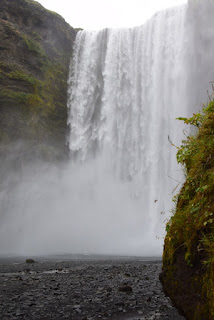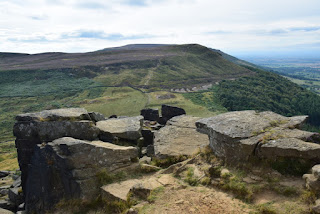Following our visit to Reykjavik during our UK to Canada cruise (see September 2016 blog) we decided that a longer trip to Iceland was required and arranged for a 12 day self drive tour where accommodation along the way had been arranged. We flew into Keflavk airport, over-nighted in a nearby hotel, picked up our car and started our anti clockwise tour with a quick trip into Reykjavik.
We made for the Hallgrímskirkja Church where I am pleased to say the remedial work to the spalling concrete was largely completed and a full frontal picture was possible. It is an imaginative design – a shuttle ready for launching to heaven perhaps.
We then opted for the coast route and on the way came across these fish head drying racks. It was in stark contrast to the surrounding acres of lava coated in moss. The dried fish heads are ground and exported mainly to Nigeria where they are used as a soup base.
The food in Iceland is wonderful with many fresh vegetables and fruit. Our first stop was Hverageroi with its wonderfully cared for flowers (which we realised subsequently was the norm) down the main street and with a great mountain backdrop.
It is the centre of quite a bit of geothermal energy much of which was used to heat green houses. Notwithstanding the long days the strawberries were also lit to bring them to picking as fast as possible.
Iceland is where the European and North American tectonic plates meet. They split the Island in two and are migrating apart at about 2 cms per year so activity with earthquakes and volcanoes is hardly surprising. (There is a volcano eruption on average every 10 years.) When building the local shopping centre they encountered a fissure that is part of the plate movement. Whether you can have a foot on either side is questionable but Helen was prepared to give it a go.
Further down the road is Pingvellir which is where Iceland's first Parliament sat back in AD 930. It is a memorable place sitting as it does on the fault lines between the two plates. The pathway on the way up to the top sits over a major fissure which has been cleaned. All very impressive until you think about when the next plate movement may occur (it is overdue). At least we missed that potential excitement.
The valley has several fault lines – it must really shake here when the plates scrape against one another - but what a powerful place to have a Parliament. Pingvellir comes from the name of the ruler at the time who had to make a decision on whether Iceland should be Paegan or Christian. After 24 hours contemplating under his cloak he opted to throw away his pagan icons and decided on Christianity.
To emphasise the unstable nature of the earth just down the road at Krisuvik were the first of many Geothermal hot springs. The proximity to the surface enables Iceland to derive most of its heating and energy from the magma below. The sulphur and bubbling were reminiscent of NZ.
A short hop down the road is Geyser. Although it used to be the largest (and hence the name that applies to similar spouts around the world) it is now a shadow of its former self and just a hot pool. Fortunately 50 metres away is a new (relatively) spout called Stokkur. This spouts every 8 – 10 minutes and goes to a height of 25 to 35 metres. (By comparison Geyser in its heyday went a comparatively monstrous 70 to 80 metres.)
In my earlier blog on C2C I had some pictures of waterfalls. With the benefit of hindsight maybe "dribble" would be a better description. This is the Gulfoss waterfall. It is enormous and deafening. Two headlines for me were that it comprised two steps (a total drop of 35 metres) at 90 degrees to one another and
the lower one discharged into a narrow canyon that was parallel to the fall so the water went out sideways. I do not know of any other waterfall that does that.
By comparison the Seljalandsfoss waterfall a little further East had somewhat less volume but is higher at 65 metres and does allow you to walk behind it.
An unusual but pretty cold and wet experience and certainly not for those wearing Birkenstocks - just bring me a photo back....
And this was quickly followed by Skogafoss waterfall of a similar height at 65 metres but a little wider at 25 metres. There were paragliders overhead enjoying the thermals generated by the falls.
As we travelled East the real wonder of Iceland quickly became apparent. The land features constantly change and are largely unique to Iceland. The first houses blend into the landscape with their turfed roofs. Even the later metal roof was cut to shape!
However, as we headed towards the first icefield the focus quickly shifted to glaciers. The Myrdalsjokull was the first to be encountered. The black volcanic ash made colour photography rather superfluous.
As the road got squeezed between the mountains and sea the local land form was rather reminiscent of Australia's Great Ocean Road.
Although not as extensive it has similar land forms with arches, pillars and smooth albeit black beaches.
However, this spot (Dyrholaey) will be remembered forever as it ticked off a long term bucket list item ….. PUFFINS – abounded in the turf atop these volcanic cliffs. Mind you humans were kept a good distance away so a zoom lens was essential.
Iceland has four major icecaps and our stop on day 4 was at Skaftafell which adjoins the largest (Vatnajokull) a spectacular sight as we approached.
By walking up a nearby rise we could see three glaciers. The one immediately behind the hotel was a bare 1 km walk. (I am guessing that the hotel has decided global warming and glacial retreat will continue as it backs onto the terminal moraine.) Here the glacier (which kept groaning and dripping) has clearly pushed up some material ahead of its migration down the valley.
Sometime ago in San Francisco we saw a man balancing rocks (see October 2014 blog). In Iceland (where there is plenty of material!) this has started to become a bit of a fad with many having a go – so not to be outdone….. Lets just say there is scope for being a little boulder.....
As we moved around the Icecap there were two glacier lagoons. The first was Breiðárlón which was much quieter than
the larger Jokulsarlon. The tide was coming in at quite a rate and pushing the icebergs back into the lagoon. All the eddies were being enjoyed by a dozen or so seals. There were also some icebergs that were clear blue and without the black ash coating that tarnished the majority.
As we reluctantly started to turn the SE corner and leave the icecaps and glaciers behind we were greeted by fiords. A whole different vista – some of which makes road construction quite a challenge. No shortage of tumbling boulders here…. We moved on quickly and looked forward to see what the North had to offer.























































































